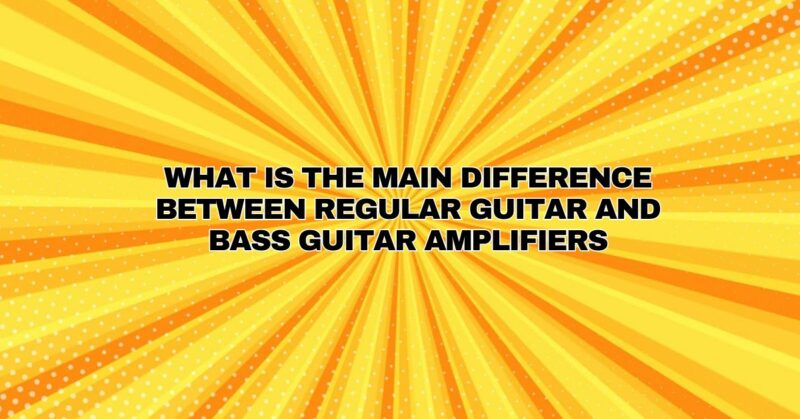Amplifiers are an essential component of any guitarist’s setup, whether you play a regular guitar or a bass guitar. While both types of amplifiers serve the purpose of amplifying the instrument’s sound, there are distinct differences in their design and functionality to cater to the unique characteristics and requirements of regular guitars and bass guitars. In this comprehensive article, we will delve into the main differences between regular guitar and bass guitar amplifiers, exploring their construction, tone shaping, and the role they play in shaping the sound of these two distinct instruments.
Construction and Design Differences
- Speaker Size and Configuration:
- One of the most noticeable differences between regular guitar and bass guitar amplifiers is the size and configuration of their speakers. Regular guitar amplifiers typically feature smaller speakers, often 8 to 12 inches in diameter, while bass guitar amplifiers utilize larger speakers, commonly 12 to 15 inches. The larger speakers in bass amplifiers are designed to move more air and handle the lower frequencies produced by bass guitars.
- Cabinet Design:
- Regular guitar amplifiers often employ open-back or partially open-back cabinet designs, which can provide a more airy and resonant sound. In contrast, bass guitar amplifiers usually use closed-back cabinets that are sealed to prevent sound leakage, focusing the low-end frequencies for a tighter and punchier bass response.
- Amplifier Wattage:
- Bass guitar amplifiers typically have higher wattage ratings compared to regular guitar amplifiers. This extra power is necessary to handle the low-frequency demands of bass guitars without distortion.
Tone Shaping and Equalization
- Tone Controls:
- Regular guitar amplifiers often feature a standard set of tone controls, including bass, midrange, and treble. These controls allow guitarists to shape the overall tonal characteristics of their sound.
- Bass guitar amplifiers typically emphasize bass and midrange controls, allowing bassists to sculpt their tone to suit different playing styles and musical genres. Some bass amplifiers also include a “contour” or “scoop” control, which adjusts the midrange frequencies to create a more scooped or pronounced sound.
- Graphic Equalization (EQ):
- Bass guitar amplifiers frequently include a graphic EQ section with sliders for specific frequency bands. This level of control enables precise shaping of the bass guitar’s tonal profile, focusing on the crucial low frequencies while taming or enhancing other frequency ranges as needed.
Signal Processing and Effects
- Overdrive and Distortion:
- Regular guitar amplifiers often feature built-in overdrive or distortion channels that allow guitarists to achieve classic rock and lead guitar tones. These effects are tailored to the midrange and high-frequency characteristics of regular guitars.
- Bass guitar amplifiers may include overdrive options as well, but these are designed to preserve the low-end clarity and definition required for bass playing. Bass overdrive effects are typically voiced to enhance the harmonic content while retaining the fundamental bass frequencies.
Conclusion
In summary, regular guitar and bass guitar amplifiers are tailored to the unique needs of their respective instruments. The main differences between the two lie in their construction, with bass amplifiers featuring larger speakers and closed-back cabinets to handle the lower frequencies of bass guitars. Additionally, bass amplifiers offer extensive tone shaping options with an emphasis on bass and midrange controls, as well as graphic EQs for precise sound sculpting. While regular guitar amplifiers may offer overdrive and distortion effects suited to the midrange and high frequencies of regular guitars, bass amplifiers include overdrive options that preserve the fundamental bass frequencies.
Understanding these distinctions is crucial for musicians seeking to optimize their sound, as using the right amplifier for the instrument ensures a well-balanced and defined tonal output that complements the unique characteristics of regular and bass guitars.


